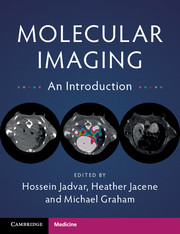Book contents
- Frontmatter
- Contents
- List of Contributors
- Preface
- 1 Instrumentation – CT
- 2 MRI/ MRS Instrumentation and Physics
- 3 Optical and Ultrasound Imaging
- 4 Instrumentation-Nuclear Medicine and PET
- 5 Quantitation-Nuclear Medicine
- 6 Perfusion
- 7 Metabolism
- 8 Cellular Proliferation
- 9 Hypoxia
- 10 Receptor Imaging
- 11 Apoptosis
- 12 Angiogenesis
- 13 Reporter Genes
- 14 Stem Cell Tracking
- 15 Amyloid Imaging
- Index
- References
8 - Cellular Proliferation
Published online by Cambridge University Press: 22 November 2017
- Frontmatter
- Contents
- List of Contributors
- Preface
- 1 Instrumentation – CT
- 2 MRI/ MRS Instrumentation and Physics
- 3 Optical and Ultrasound Imaging
- 4 Instrumentation-Nuclear Medicine and PET
- 5 Quantitation-Nuclear Medicine
- 6 Perfusion
- 7 Metabolism
- 8 Cellular Proliferation
- 9 Hypoxia
- 10 Receptor Imaging
- 11 Apoptosis
- 12 Angiogenesis
- 13 Reporter Genes
- 14 Stem Cell Tracking
- 15 Amyloid Imaging
- Index
- References
Summary
Controlled proliferation is an important physiologic cellular function. However, uncontrolled cellular proliferation is one of the major hallmarks of cancer. Imaging cellular proliferation may provide valuable diagnostic information about the rate of tumor growth and an opportunity for objective assessment of early response to treatment. Positron emission tomography (PET) in conjunction with radiotracers that track the thymidine salvage pathway of DNA synthesis has been studied extensively for imaging cellular proliferation in cancer. Initially, [11C-methyl]thymidine ([11C-methl]TdR) was synthesized for this purpose but the radiotracer had the major limitation of rapid catabolism. Further research resulted in the development of new radiolabeled analogs that were resistant to catabolism. Those radiotracers labeled with 18F are of particular interest since the longer isotope half-life (110 min) facilitates regional distribution of the tracer without the need for an on-site cyclotron. In this chapter, we briefly describe the experience with two of these radiotracers, [18F]-3’-deoxy-3’-fluorothymidine (18F-FLT) and [18F]-2’-fluoro-5-methyl-1-beta-D-arabinofuranosyluracil (18F-FMAU) (Figure 8.1).
[18F]-FLT
18F-FLT is the most studied cellular proliferation PET tracer. The radiotracer is phosphorylated by thymidine kinase 1 (TK1), retained in proliferating cells without DNA incorporation, and can be described by a three-compartment model. Normal biodistribution of 18F-FLT demonstrates relatively high uptake in the liver and the bone marrow with urinary bladder receiving the highest dose through renal excretion. Typically 18F-FLT demonstrates lower uptake than 18F-FDG in tumors, although in some anatomic regions, such as the brain, the target-to-background uptake ratio is higher with 18F-FLT than with FDG (given the high physiologic FDG uptake in the brain gray matter). Tehrani and Shields recently summarized the literature on the major clinical investigations with 18F-FLT. These authors caution that not all tumors with high proliferation may show high 18F-FLT uptake due to a variety of factors including the type of cancer and treatment, and biologic processes such as balance between de novo and salvage pathways of DNA synthesis, and balance between increased proliferation rate and decreased apoptosis.
The low 18F-FLT uptake in the normal brain is an advantage that has been investigated for the grading of brain tumors, differentiation of radiation necrosis from residual or recurrent tumor, assessment of treatment response, and in prognostication.
- Type
- Chapter
- Information
- Molecular ImagingAn Introduction, pp. 36 - 38Publisher: Cambridge University PressPrint publication year: 2017



